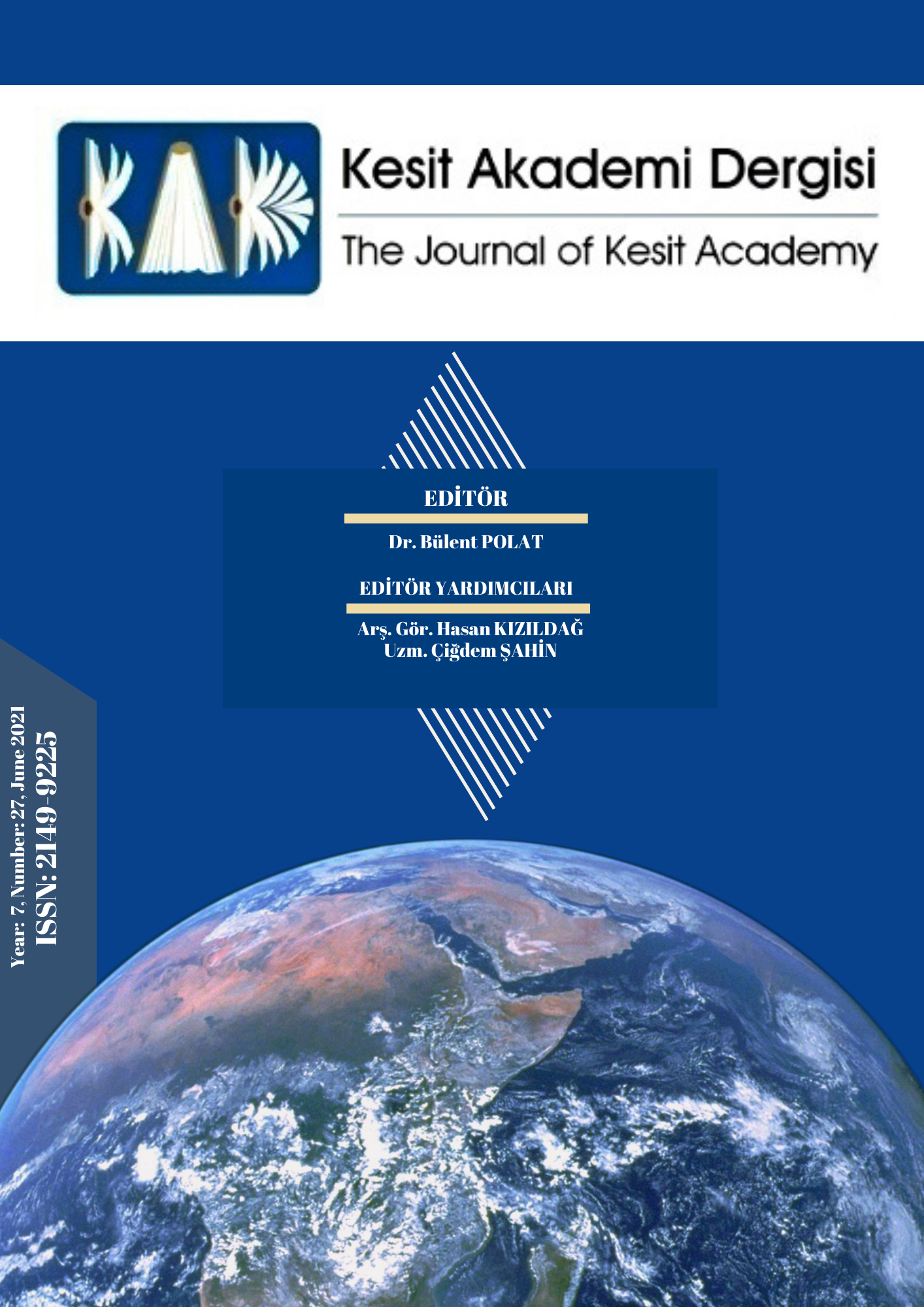Author :
Abstract
Geleneksel sanat ve bilim öğretileri nokta ile başlatılır. Noktanın hareketi ile oluştuğu kabul edilen çizgi ile devam eder. Bu olgulara zamanla soyut kavramlar eklenmiştir. Nokta ve çizgi, güzel sanatlar ve bilimin temel öğelerinden biridir. Nokta ve çizgi insanın kültürel, sosyolojik ve sanatsal yaşamında en önemli ifade araçları olmuştur. Tarihsel süreç içerisinde insanlar çevrelerinde gördükleri kadın-erkek, sıcak-soğuk, aydınlık-karanlık, büyük-küçük, iç huzur-korku, neşe-üzüntü gibi zıtlıkları fark etmişler ve bazılarını kutsallaştırmışlardır. İnsanlar çevrelerindeki nesne ya da doğa olaylarını nokta ve çizgi yardımıyla im, sembol, simge, motif ve desenler haline getirerek görselleştirmiştir. İnsan, fiziksel ve biyolojik yapısını koruyabilmek, yaşadığı ortamdan zarar görmemek için giyinmek ya da örtünmek zorundadır. Bu nedenle insanların post, keçe, düğüm, örme ve dokumalara gereksinimleri vardır. Ayrıca insanlar yaşadıkları ortamlarda çeşitli dokumalar kullanmaktadırlar. Toplum bilinci ve sosyalleşmenin gelişmesiyle gösteriş, statü, moda gibi kavramlar etkisinde dokumalar dokunmuştur. Bu dokumalar malzeme, teknik, renk, motif ve desenleri ile çeşitlenerek gelenekselleşmiştir. Geleneksel dokumalarda kullanılan motifler, kendilerine özgü kültürel, mitolojik ve sanatsal değerler barındırmaktadır. Bu araştırmada; geleneksel dokumalar incelenecek, geleneksel dokumalarda motif ve desen arasındaki bağlantılar tasarım yönünden açıklanacaktır.
Keywords
Abstract
Traditional art and science teaching are started with the point. It continues with the line that is assumed to be formed by the movement of the point. Abstract concepts have been added to these phenomena in time. Point and line are one of the basic elements of fine arts and science. Points and lines have been the most important means of expression in human’s cultural, sociological and artistic life. In the historical process, people have noticed the contrast such as woman and man, hot and cold, light and dark, big and small, tranquillity and fear, joy and sadness and sanctified some of them. Human have visualized the objects or natural phenomena in their environment by turning them into signs, symbols, symbols, motifs and patterns with the help of points and lines. Human beings need to have been worn or cover themselves in order to protect their physical and biological structure and not to be harmed by the environment in which they live. Therefore, people need animal hides, felt, knots, knitting and weaving. In addition, people use various weavings in their living places. With the development of social awareness and socialization, under the influence of concepts such as show off, vanity, status, fashion and weavings were woven. These weavings have become traditional by diversifying with materials, techniques, colours, motifs and patterns. The motifs used in traditional weavings contain unique cultural, mythological and artistic values. In this study; traditional weavings will be examined and the connections between motifs and patterns in traditional weavings will be explained in terms of design.
Keywords
- Akpınar, H. F., Begiç, H. N. ve Kuzay Demir, G. (2020). Çözgüden Düğüme, Düğümden Motife Bergama Halıları. Ankara: Nobel Akademik Yayıncılık Eğitim Danışmanlık Tic. Ltd. Şti.
- Arslan, C. (2007). Çizginin Sanatsal Tekstildeki Yeri. Yayımlanmamış Sanatta Yeterlik Tezi. Marmara Üniversitesi Güzel Sanatlar Enstitüsü. İstanbul.
- Ateş, M. (1996). Mitolojiler Semboller ve Halılar. İstanbul: Symbol Yayıncılık.
- Ateş, M. (2001). Mitolojiler ve Semboller “Anatanrıça ve Doğurganlık Sembolleri”. İstanbul: Mehmet Ateş (Kendisi).
- Ateş, M. (2014). Mitolojiler ve Semboller “Ana Tanrıça ve Doğurganlık”. İstanbul: Milenyum Yayın- ları Ltd. Şti.
- Böhmer, H. (2004). Nomaden In Anatolien. Schweinfurt: Remhöb-Verlag.
- Burckhardt, T. (2017). Doğu’da ve Batı’da Kutsal Sanat (Çev.: T. Uluç). İstanbul: İnsan Yayınları.
- Cıbıroğlu, Y. (2007). Sedef Kakmalı Ayakkabı Boyacı Sandıkları Üzerindeki Arketipsel (S)imgeler. İs- tanbul: Arkeoloji ve Sanat Yayınları.
- Eroğlu, Ö. (2016). Soyutlama ve Duyumsama Wilhelm Worringer “Bir Okuma Çalışması”. İstanbul: Tekhne Yayınları.
- Eroğlu, Ö. (2017). Sanatta Üslup. İstanbul: Tekhne Yayınları.
- Eroğlu, Ö. ve Yurdun, Ö. A. (2017). Kandinsky: Nokta ve Çizgiden Yüzeye. İstanbul: Tekhne Yayın- ları.
- Ersoy, N. (2000). Semboller ve Yorumları (Bölüm I-II). İstanbul: Dönence Yayınları.
- Eyüboğlu, B. R. (1986). Resme Başlarken. İstanbul: Bilgi Yayınevi.
- Gadamer, H.-G. (2017). Güzelin Güncelliği (Çev.: F. Tepebaşılı). İstanbul: Çizgi Kitabevi.
- Glassie, H. (1993). Turkish Traditional Art Today. Indiana: Indiana University Press.
- Guénon, R. (2017). Yatay ve Dikey Boyutların Sembolizmi (Çev.: F. Topçuoğlu). İstanbul: İnsan Yayınları.
- Gülensoy, T. (1989). Orhun’dan Anadolu’ya Türk Damgaları. İstanbul: Türk Dünyası Araştırmaları Vakfı Yayını.
- Gündüz, G. (2002). Kargaşa, Kaos ve Şekil Oluşumları. Ankara: METU PRESS – ODTÜ Geliştirme Vakfı Yayıncılık ve İletişim A.Ş.
- Klee, P. (2002). Modern Sanat Üzerine (Çev.: R. G. Öğdül). İstanbul: Altıkırkbeş Yayın.
- Mallet, M. (1998). Woven Structures. Atlanta: Christopher Publications.
- Pastoureau, M. (1997). Şeytan Kumaşı, (Çev.: İ. Yılmaz). İstanbul: İletişim Yayıncılık A.Ş.
- Read, H. (1974). Sanatın Anlamı. İstanbul: Türkiye İş Bankası Sanat Yayınları.
- Shiner, L. (2001). Sanatın İcadı (Çev.: İ. Türkmen). İstanbul: Ayrıntı Yayınları.
- Uğurlu, A. (1985). Antik Çağ Anadolu Dokuma Sanatı. İlgi Dergisi, 43: 11-17.
- Uğurlu, A. (1986). Dokusal Yüzeylerde Motif ve Desen Biçimleri. Sanat Çevresi Dergisi, 88: 38-40.
- Uğurlu, A. (1991). Anadolu Dokumalarında Motif Felsefesi. Tekstil ve Mühendis Dergisi, 26:76-82.
- Uğurlu, A. (2000). Anadolu El Dokumacılığı. Ev Tekstili Dergisi, 24: 19-21.
- Uğurlu, S. S. (2016). Geometrik Motifli Anadolu Dokumaları. VI. Uluslararası Türk Sanatı, Tari- hi ve Folkloru Kongresi / Sanat Etkinlikleri, 12-14 Mayıs 2016, Konya.
- Worringer, W. (2017). Soyutlama ve Özdeşleyim (Çev.: İ. Tunalı). İstanbul: Hayalperest Yayınları.
- Yağan, Ş. Y. (1978). Türk El Dokumacılığı. İstanbul: Türkiye İş Bankası Kültür Yayınları.
